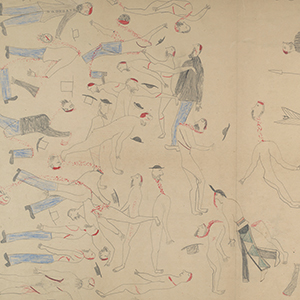

Consider the life of General George Armstrong Custer. On the one hand, we have a new biography, Custer’s Trials: A Life On The Frontier Of A New America, by National Book Award winner T.J. Stiles.
Stiles, during a recent appearance on NPR, thoughtfully attempts to rehabilitate Custer’s reputation, “Don’t make him bear the weight of American history.” He also humanizes him by quoting from a letter to Custer’s cousin Augusta Ward: “So far as the country is concerned, I, of course, must wish for peace and will be glad when the war has ended.”
If you weren’t a Native American, the argument probably holds weight.
On the other hand, the new exhibit “Red Horse: Drawings of the Battle of the Little Bighorn” at the Cantor Arts Center proposes an entirely different perspective. Red Horse was a ledger artist and a Minneconjou Lakota Sioux warrior who fought against Custer and the 7th Cavalry at the Battle of the Little Bighorn in June 1876.
There are 12 drawings on display. Most of them depict soldiers on horseback with various lengths of Abraham Lincoln-esque facial hair. One drawing even gives each white soldier a stovepipe hat along with his chinstrap beard. At first glance, they bring to mind Asian scroll prints with brightly drawn, multicolored horses without the background information of a field or a sky; or even the work of a young, aspiring artist with a head full of cowboys and Indians and a new box of colored pencils.
In context, however, these drawings take on much greater significance. These are not idle doodles of a bored grade schooler in social studies class; rather they are a soldier’s tabulations of carnage.
he Native Americans are also moving across the field—everyone is in motion. Few of the paintings depict the conflict itself: Red Horse simply and effectively draws what he sees, and some of what he sees is teepees, a dozen bloody soldiers (some of them decapitated), headdresses. In some ways, his art is as impartial as an illustrator in a modern courtroom.
Regardless, if the exhibit doesn’t make as much of a cultural impact as the Custer biography, at least Little Bighorn is represented in some small way by the Sioux themselves.
Red Horse: Drawings of the Battle of the Little Bighorn
Jan 16-May 9, Free
Cantor Arts Center, Stanford


